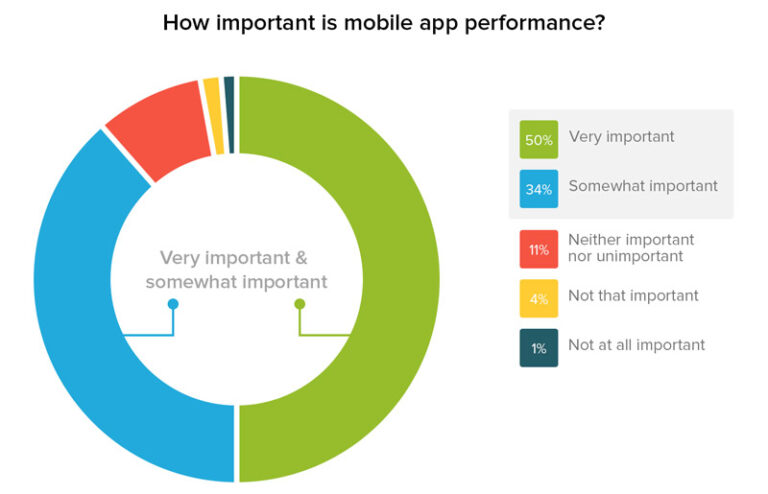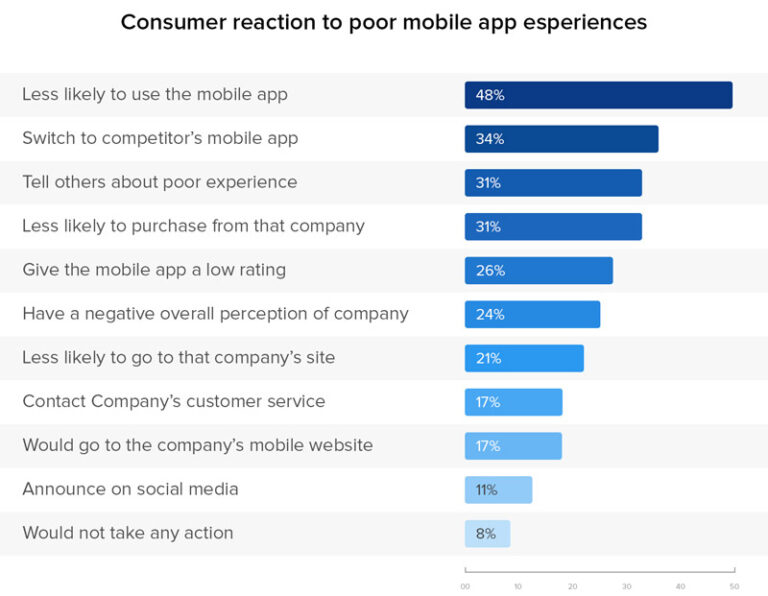Before addressing a subject that most people would like to settle, let us tell you something you already know, just to touch base here. Mobile phones are extremely precious to us. In fact, we are obsessed with it. The statistics of mobile phone addiction go on and on. Studies say, while 84% of adults in the US couldn’t go a day without their phones, the average time spent per day by an adult on their phone is not more than 3 hours.
This begs the question – can anyone afford to waste even a minute of their time on your lousy app? It’s such a challenge to get users to try out your app already, why would you want to give them a bad experience once you have them over?
While 79 percent of consumers would retry a mobile app only once or twice if it failed to work the first time, only 16 percent would give it more than two attempts.
It’s been years after the first smartphone was introduced to the world, and today, we simply cannot imagine a world without smartphones. It’s a known fact that smartphones provide the best platform to connect with your consumer, via applications.
Deciding an approach to go about building your mobile application is meticulous, sure! Although whether to go for a hybrid app or a native app doesn’t take much of a genius. There are various factors that weigh their worth here, like time to market, cost of development, ease of maintenance, etc. But if you’re in it to win it, what matters the most in the long run is, the app performance over all that brings out an awesome user experience.

The two approaches that we’re about to discuss here are – Hybrid and Native. This, actually, is not an argument to be diplomatic about. It’s pretty much obvious that native apps perform way better than hybrid apps. They provide better responsiveness, higher security and over all, they “feel right” compared to the sub-par performance of hybrid apps. But hybrid apps come with their own perks.
Here’s drilling the two down to their surface, helping you make your call being more informed and educated.
What is a hybrid app?
A hybrid app is built to run on multiple platforms, hence, it is platform-agnostic. A hybrid app is essentially an isolated instance of a browser that runs the web view of your app inside a native app wrapper. This wrapper helps the web view communicate with the device platform. Needless to say, whatever you see, touch and feel on your app, doesn’t directly communicate with your device platform. The communication happens using third party tools that are specifically built to facilitate the flow.
How is a hybrid app built?
Honestly, the skills required to develop hybrid apps are not as much as those for native. If you’re a web developer, you’re pretty much a hybrid app developer also. When you build a hybrid app, you code it once and it is compiled to run on both platforms (iOS and Android). Clearly, the investment in terms of time, money and skills for developing hybrid apps is a lot less than that for native apps.
There are numerous frameworks out in the market to develop hybrid apps. The top two by far are Ionic and React Native. Ionic (backed by Google) has a more traditional approach of development with HTML, CSS and JavaScript where as React Native (backed by Facebook) produces a more native-like applications built under one common language, JavaScript.
Pros and Cons of a hybrid app?
| Pros | Cons |
| Profitable as one code base works for multiple platforms | Poor user experience |
| Initial speed to market is faster than native apps | Hardware access limitations |
| Low cost of development and maintenance | Dependency on external plugins, limitations to feature complexity |
| Perfectly suited for an MVP | Higher cost of support |
Best case usage of a hybrid app?
– When you have a minimum set of features to try out the market response with an open mind, so you can have them all rebuilt later should you decide to go all in (classic MVP)
– When your budget is low
– When you don’t really care about the user experience, because users will never not come back to your app, as you don’t have a competitor (a lot is wrong with this case by the way)
What is a native app?
Unlike hybrid apps, native apps are platform-specific. They download most of the content when the user first installs the app. Also, native apps have direct access to all device functionalities. This is mainly the reason why, if you’re developing a mobile game that renders a lot of animation or even an app that is about anything high in quality processing, like augmented reality, you must go native!
The user experience with a well developed native app is always seamless. However, the trade-off here is that you would have to code separately for each operating system you want to release your app for.
How is a native app built?
A native app cannot function on a device that doesn’t have the same operating system. If you want your app to run on iOS and Android, you’re going to have to develop the app twice. This makes the development process both slower and more expensive. Not to mention, the skills required to develop these apps are rare, exclusive and expensive.
For Android, native apps are built in Java and for iOS, they’re built in Objective C or Swift. Also, it is critical that the apps follow specific technical and UI/UX guidelines.
Pros and Cons of a native app?
| Pros | Cons |
| Users learn to use the app quickly as the UX standards are familiar already | High development cost |
| Extremely fulfilling user experience | Low profitability as it demands maintenance of multiple code bases |
| Easy to find on App Store and Play Store | Low speed to market |
| High security | Skills required to develop the app are rare and expensive |
Best case usage of a native app?
– When your app requires access to device features like camera, GPS, etc.
– When you have competition in the market both existing or upcoming
– When all you care about is user experience
For a company trying to get out there on App Store and Play Store, the question is whether you see yourself in the game for a long time; as opposed to how much money do you have. Because, if you plan to be out there long term, beating your competitors, getting new users everyday and retaining your existing users will be on your priority list. You wouldn’t want to give your users a bad experience.

Smartphone users, after going through the tedious task of learning how to use their phones and getting familiar to all the features, do not want to learn how to use your app (especially when there are competitors that they’re used to, already). There’s a certain way users expect their apps to work from a navigational and interactive perspective. You do not want to deviate from that, unless ‘user experience’ is not your priority (we sincerely hope that’s not the case). These things can well be achieved by Native apps.
To wrap things up – your app could be an MVP or a full fledged product, it could be representing a huge brand or not, it could serve a great purpose and might not even have a competition – for any case, users are your end point and users do not love using hybrid apps (even though they do not know what hybrid apps are).
